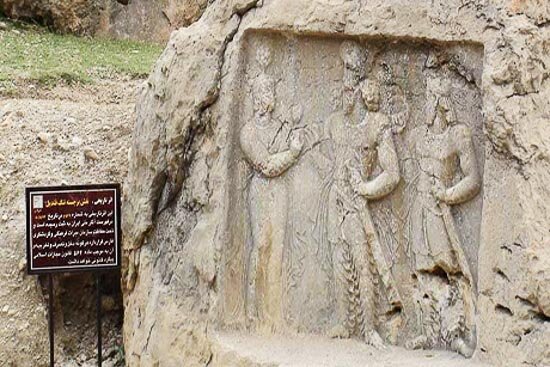Sarab-e Qandil: a puzzling Sassanid bas-relief in southern Iran

TEHRAN - Sarab-e Qandil (literary meaning “Ice-cold Spring”), is one of many reliefs in southern Iran, which may still bear untold stories. Its isolation from frequented roads might explain its excellent state of conservation: it was not accessible for vandals.
Situated near the modern city of Kazerun in Fars province, the Sassanid-era (224-651 CE) relief has a quadrangular frame, carved on an isolated rock beside the bed of a river, without having been much eroded or damaged by the water.
It depicts a queen offering a lotus flower to her husband [widely believed to be the Iranian king Bahram II (r.276-293)]. The two characters look at each other, while a prince (probably their son, the future king Bahram III) holds a ring of power.
The carving is well-executed; special attention has been paid to the clothes, which show beautiful and fine details, giving an impression of lightness, of aerial movement. The king appears to wear his winged crown and jewels. His left hand is on the top of his sword. His right hand is open, waiting for the gift. The composition shows the royal figure at the center of the panel, the queen is on his right, the prince being on his left/back.
Although this relief is generally attributed to Bahram II, the lack of an inscription makes that experts couldn’t be completely certain. The main arguments for identification with Bahram II lay in the fact that he is the only Sasanian king who showed his queen on coins, and that the female figure might appear to be dressed more like a queen and not a goddess. Scholars like Vanden Berghe and Aerinck, therefore, think that the relief can be attributed to Bahram II. However, Lewitt-Tawill maintains that the relief represents Ardashir I and the goddess, the prince being Shapur I.
Soon after Bahram II, the son and successor of Bahram I was enthroned, he was forced to defend his position against a brother, Hormizd, viceroy of the eastern provinces.
The Sassanid era is of very high importance in the history of Iran. Under Sassanids, Persian art and architecture experienced a general renaissance. Architecture often took grandiose proportions such as palaces at Ctesiphon, Firuzabad, and Sarvestan that are amongst highlights of the ensemble.
AFM
Leave a Comment